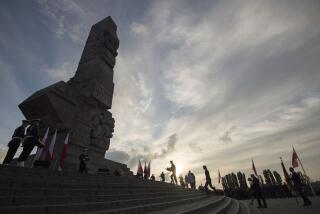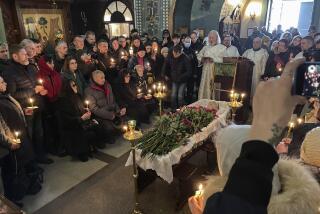Czar’s Remains to Be Buried in St. Petersburg
- Share via
MOSCOW — Russia’s last czar and his family will be buried in St. Petersburg, the former imperial capital, on July 17, exactly 80 years after they were executed, the government announced Friday.
Although the Russian Orthodox Church still has doubts, this announcement is the final word in a debate that has run for years over where--and with how much pomp and ceremony--to inter Nicholas II, his wife, Empress Alexandra, three of their five children and the family doctor and servants killed with them in the aftermath of the Bolshevik Revolution.
First Deputy Prime Minister Boris Y. Nemtsov said the bones will be buried in golden-spired Peter and Paul Fortress on the Neva River, in St. Catherine Cathedral, where members of the Romanov dynasty have been laid to rest since Peter the Great.
Details--including whether servants will be put next to their royal masters--are still unclear.
“All the members of the government, without exception, voted for this decision,” said Nemtsov, who headed a commission that in January produced a 1,500-page report authenticating the remains.
President Boris N. Yeltsin, who was supposed to make the final decision, on Tuesday passed responsibility for it to the commission, which ruled after a 3 1/2-hour meeting Friday that was also attended by the church’s representative, Metropolitan Yuvenaly.
The church, which believes that the imperial family members are martyrs and wants to make Nicholas a saint once it is sure the remains being buried are really his, doubts the proofs provided by genetic and forensic tests.
On Thursday, its Holy Synod publicly refused to recognize the remains as those of the executed royal family, but it added that it will not oppose their burial.
“The church cannot make a mistake” on the issue, Yuvenaly said Friday, suggesting that the bones should be given a temporary resting place until all remaining doubts are eliminated. But he added: “The church will not create problems for anyone. The Holy Synod’s decision was a moral one; the government’s decision is a legislative one.”
The skeletons of nine victims were exhumed from a shallow mass grave near Yekaterinburg, in the Ural Mountains of central Russia, in July 1991, 73 years after the imperial family was executed by a Communist firing squad in the cellar of the house where they were being kept prisoner. After the 1918 killings, the bodies were dumped in a shallow, common grave and sprayed with acid. Communist authorities wanted the site of the royal grave kept secret.
The bones of one daughter and of Nicholas’ 13-year-old son, Alexis, a hemophiliac who until the revolution had been heir to the Russian throne, were not buried in the common grave.
Nemtsov said that “there is no one in the government who had any doubt about the appropriateness of the burial taking place in St. Petersburg.”
Officials in Yekaterinburg had been keen to keep the bones in central Russia. Yuri M. Lushkov, Moscow’s mayor, had wanted them in his city. Opinion polls show that 50% of Russians today favor burying the royal remains in St. Petersburg. Only 27% doubt the authenticity of the remains.
More to Read
Sign up for Essential California
The most important California stories and recommendations in your inbox every morning.
You may occasionally receive promotional content from the Los Angeles Times.












